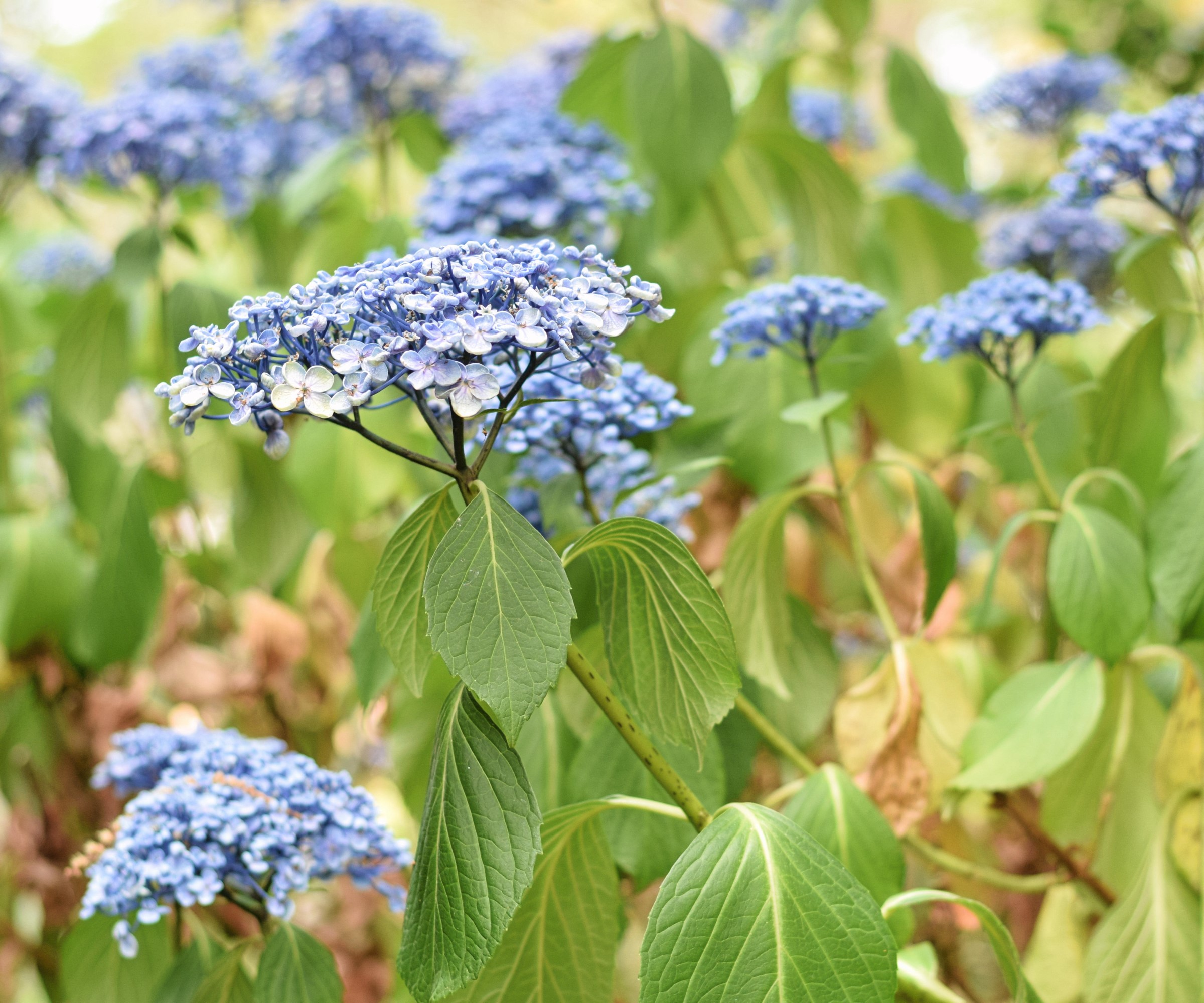'Prevention is key' – expert tips for dealing with 8 common hydrangea diseases
What to do if your hydrangeas are hit by some of the most common diseases out there


No matter what type of hydrangea you are growing, there is a long list of diseases that could potentially threaten them. Whether it be fungal or bacterial problems, all parts of the hydrangea can be hit and there is nothing that can be done but remove plants if some diseases strike.
Hydrangeas come in many species and varieties, with their large and showy flowerheads hugely popular among gardeners. They are highly versatile, easy to grow, and are great options for shady areas of the backyard.
If you are growing hydrangeas for these reasons and more, and want to discover more about hydrangea diseases, we take a look at eight of the most common. This includes the signs to look out for, what can be done to alleviate the potential risks, and what remedies are out there if your plants succumb to any of the diseases.

Hydrangeas are impactful shrubs for the yard
How to spot hydrangea diseases
Hydrangea diseases can be classified into two groups, either fungal or bacterial. Fungal diseases are caused by spores and tend to affect the flowers and foliage. The fungal spores can be spread from plant-to-plant by the rain, wind, and also by gardeners on their tools and bodies.
Bacterial diseases can hit most of the plant’s tissues and are often spread by insects or tools. The infections are often systemic and there is no cure, so unfortunately immediate removal and disposal of infected plants is recommended. Never add diseased plant material to your home compost.
Lorraine Ballato, author of the bestselling book Success with Hydrangeas, available on Amazon, advises that ‘regular, frequent scouting is critical so you can deal with conditions at early stages to control the spread’ of hydrangea diseases.
The hydrangea expert also recommends that ‘garden sanitation is a key control method’ along with ensuring good air circulation through plants.
Design expertise in your inbox – from inspiring decorating ideas and beautiful celebrity homes to practical gardening advice and shopping round-ups.
This includes cleaning up debris and fallen leaves along with the ‘sterilization of all tools and surfaces with disinfectants’ in order to help prevent the spread of both fungal and bacterial diseases.

Lorraine Ballato is a hydrangea expert and the the author of the international best selling book 'Success with Hydrangeas', available at Amazon. She is also an in-demand speaker throughout the US and the resident hydrangea expert at the New York Botanical Garden.

Blooms and leaves can show signs of hydrangea diseases
1. Powdery mildew
Powdery mildew on hydrangeas is caused by fungal pathogens and shows as white or grey powdery coatings on leaves and flowers. Affected parts of the plants may also show signs of distorted growth.
It can be caused by poor air circulation. Correct planting of hydrangeas at good spacings in well-ventilated areas, with opportunity for airflow, can help reduce the risks of infection. Watering hydrangeas is best done at the base of the plant and avoiding overhead watering, which is an often-seen garden watering mistake, can stop the spores from being dispersed from leaves to leaves.
You can get fungicides to treat powdery mildew that can help to manage the problem, such as Earth's Ally Disease Control Concentrate, available at Amazon.
Lorraine Ballato warns that, with all fungal diseases of hydrangeas, the problems ‘can be treated once discovered but can’t be reversed’. She adds: ‘Treatments prevent spread and are specific to each disease. Pathogens must make contact with treatment, ergo preventive treatments not possible.’

Powdery mildew covers leaves in a white coating
2. Rust
Rust on hydrangeas can be a common disease and it is a fungal problem that thrives in humid conditions. The signs of rust are rusty-orange or reddish-brown spots on the underside of leaves, often along with yellowing leaves and defoliation. Rust can weaken the plant and any infected leaves need to be removed, and any fallen leaves picked up and disposed of.
Like with many other fungal diseases, improving air circulation through proper spacing and hydrangea pruning helps combat rust. Fungicidal treatments for rust are available for control and management of the disease, such as the Garden Safe Fungicide 3 Concentrater available at Walmart.

Rust is also common on roses and shows as colored spots
3. Botrytis
Hydrangea botrytis blight appears as brown spots or blotches on leaves and buds. It is a disease that thrives in damp and cool conditions, threatening to reduce blooms and potentially lead to rot.
Ensure air circulation, plant hydrangea at proper spacings and avoid overhead watering. Any infected parts of the plant need to be removed and discarded. If the problem persists, then fungicidal sprays can be applied as necessary.
4. Leaf Spot
Leaf spot is another common fungal disease that can cause irregular black spots on hydrangea leaves. The leaves can then start to turn yellow and begin to drop from the plant. Leaf spot not only diminishes the look of the hydrangea, but it weakens the overall health of the plant. Any leaves affected with spots, which can range from brown to black in color, need to be removed and disposed of. Do not use diseased leaves to make leaf mold for the yard.
Robin Phelps, an experienced hydrangea grower and the gardening coach for Sow Many Plants, recommends: ‘To combat leaf spot, it is advisable to prune any infected foliage, improve air circulation around the plants, and avoid overhead watering. Additionally, applying fungicides labeled specifically for leaf spot control can help manage the disease and prevent its further spread.’

Black spots on hydrangea leaves are caused by leaf spot
5. Anthracnose
Anthracnose hits hydrangeas with brown spots on hydrangea leaves and flowers, and these can grow quickly. The disease likes warm and wet conditions and spreads easily by rain or irrigation. The infected tissue will show dark lesions that start to look like a bullseye and then can die. The plant will suffer from reduced vigor and that makes it more susceptible to other pests and diseases.
Proper drainage, good air circulation, and only watering the base of the hydrangea are all recommended. Prune and remove infected parts of plants and apply fungicidal treatment as required. Sprays made from neem oil can also be used against fungal diseases such as anthracnose, one example is the HARRIS Neem Oil Spray available at Amazon.
6. Bacterial wilt
Bacterial wilt is a disease that affects the flowers and leaves. The first sign tends to be wilted flowers and leaves and it can spread rapidly through the hydrangea and cause the entire plant to die. The bacteria that causes the problem commonly gets into the plant through wounds from pruning or damage, or in natural openings caused by insects.
Only use clean and sharp pruning shears when pruning hydrangeas and sanitize tools to prevent the transfer of bacteria from plant-to-plant. There are no options available to treat bacterial wilt and any infected plants should be removed and destroyed to prevent the spread of the bacteria.

Wilting leaves can be a sign of disease
7. Mosaic Virus
Mosaic virus will display mosaic-like yellow patterns all over leaves and the leaf veins may also be yellow. The foliage may also be distorted and flowers can look blotchy.
There is no cure for viral infections such as mosaic virus and infected plants need to be removed and disposed of. The virus can be transmitted through garden tools and also insects, such as aphids.
Regular cleaning of garden tools is always recommended to reduce the risks of spreading diseases. Also, consider companion planting techniques when thinking of what to plant with hydrangeas, this can attract beneficial predators and can be one way to get rid of aphids and other potential troublesome insects in the yard.

Mosaic virus attacks a range of plants and shows as yellow patterns on leaves
8. Ringspot Virus
While mosaic virus displays patterns over the leaves, ringspot virus causes small yellow rings that appear on the hydrangea leaves. It is spread by pollen or by sap-sucking insects such as aphids or thrips. As well as the yellow rings, infected plants may also show signs of distorted growth and overall decline of health.
Bryan Clayton, who has over 20 years of experience in landscaping and is the CEO of GreenPal, recommends that ‘prevention is key’ as there is no cure for viral diseases that hit hydrangeas, including ringspot virus. He again advises that best practice should be to ‘control insects and pests that can spread these viruses, and remove any infected plants’.
Hydrangeas are hugely popular plants in yards, they are one of the best shrubs for shade and can produce a fantastic show of blooms every year. You can even grow hydrangeas in pots if you do not have a lot of space. While you are doing other key tasks, including watering, fertilizing hydrangeas and deadheading hydrangeas, keep your eyes open to scout for signs of diseases on your plants. Spotting any issues early will help control the spread and could potentially save your hydrangeas.

Drew has worked as a writer since 2008 and was also a professional gardener for many years. As a trained horticulturist, he worked in prestigious historic gardens, including Hanbury Hall and the world-famous Hidcote Manor Garden. He also spent time as a specialist kitchen gardener at Soho Farmhouse and Netherby Hall, where he grew vegetables, fruit, herbs, and cut flowers for restaurants. Drew has written for numerous print and online publications and is an allotment holder and garden blogger. He is shortlisted for the Digital Gardening Writer of the Year at the 2025 Garden Media Guild Awards.